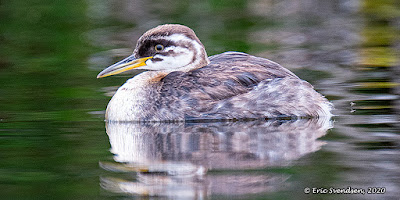Juvenile red-necked grebe nearing adulthood
Red-necked grebes are often a common sight when paddling during the spring and summer months. Early on a pair of these fish-eating ducks build a nest out of aquatic plants heaped in a pile until it emerges above the waterline. When the nest appears eggs are laid (2-6) and both parents incubate and tend the impending brood. The chicks have a comical zebra pattern when their feathers develop. They are gradually replaced by the adult plumage as summer turns to fall.
I was paddling on Lake Nakuman, northeast of Edmonton one day, and came across a number of juvenile water birds. I saw young pied-billed grebes, western grebes, and red-necked grebes. Each one differed from its adult facsimile to the point that I had to refer to a few of my bird books to verify identification. I found the juvenile red-necked grebes relatively easy though as I recognized elements of both chick and adult patterns.
To see what I mean by this, look at the head of the bird in my photograph. You can see the black and white stripes present which seem to fade as they proceed down the neck. Then there is a hint of red developing lower on the neck; it will eventually express itself fully when the final iteration arrives. The back of the grebe, sporting a streaked ruddy-brown pattern, is more adult-like than the rest of the bird. I always enjoy seeing how a chick morphs plumage; think of the bright yellow fuzz-balls we see in newly fledged chickens and how they change to adult form in a matter of weeks. It is always amazing.
The young at this time are free from the tutelage of both parents; they swim freely on their own exploring the depths while prowling for a meal. As I paddle along they disappear into the waters and emerge a short distance away. One day, not too far away, their adult form will emerge and they will be ready for the journey that will take them to unknown lands far south of here.
Thanks for reading. Ericspix Eric Svendsen
I was paddling on Lake Nakuman, northeast of Edmonton one day, and came across a number of juvenile water birds. I saw young pied-billed grebes, western grebes, and red-necked grebes. Each one differed from its adult facsimile to the point that I had to refer to a few of my bird books to verify identification. I found the juvenile red-necked grebes relatively easy though as I recognized elements of both chick and adult patterns.
To see what I mean by this, look at the head of the bird in my photograph. You can see the black and white stripes present which seem to fade as they proceed down the neck. Then there is a hint of red developing lower on the neck; it will eventually express itself fully when the final iteration arrives. The back of the grebe, sporting a streaked ruddy-brown pattern, is more adult-like than the rest of the bird. I always enjoy seeing how a chick morphs plumage; think of the bright yellow fuzz-balls we see in newly fledged chickens and how they change to adult form in a matter of weeks. It is always amazing.
The young at this time are free from the tutelage of both parents; they swim freely on their own exploring the depths while prowling for a meal. As I paddle along they disappear into the waters and emerge a short distance away. One day, not too far away, their adult form will emerge and they will be ready for the journey that will take them to unknown lands far south of here.
Thanks for reading. Ericspix Eric Svendsen




Comments
Post a Comment